A Case Study of Clinical Deterioration in a Patient with Benign Prostatic Hyperplasia
VerifiedAdded on 2023/06/08
|9
|2739
|350
AI Summary
This paper discusses a case study of clinical deterioration in a patient with benign prostatic hyperplasia, including pathophysiology, nursing care priorities, and multidisciplinary team involvement.
Contribute Materials
Your contribution can guide someone’s learning journey. Share your
documents today.
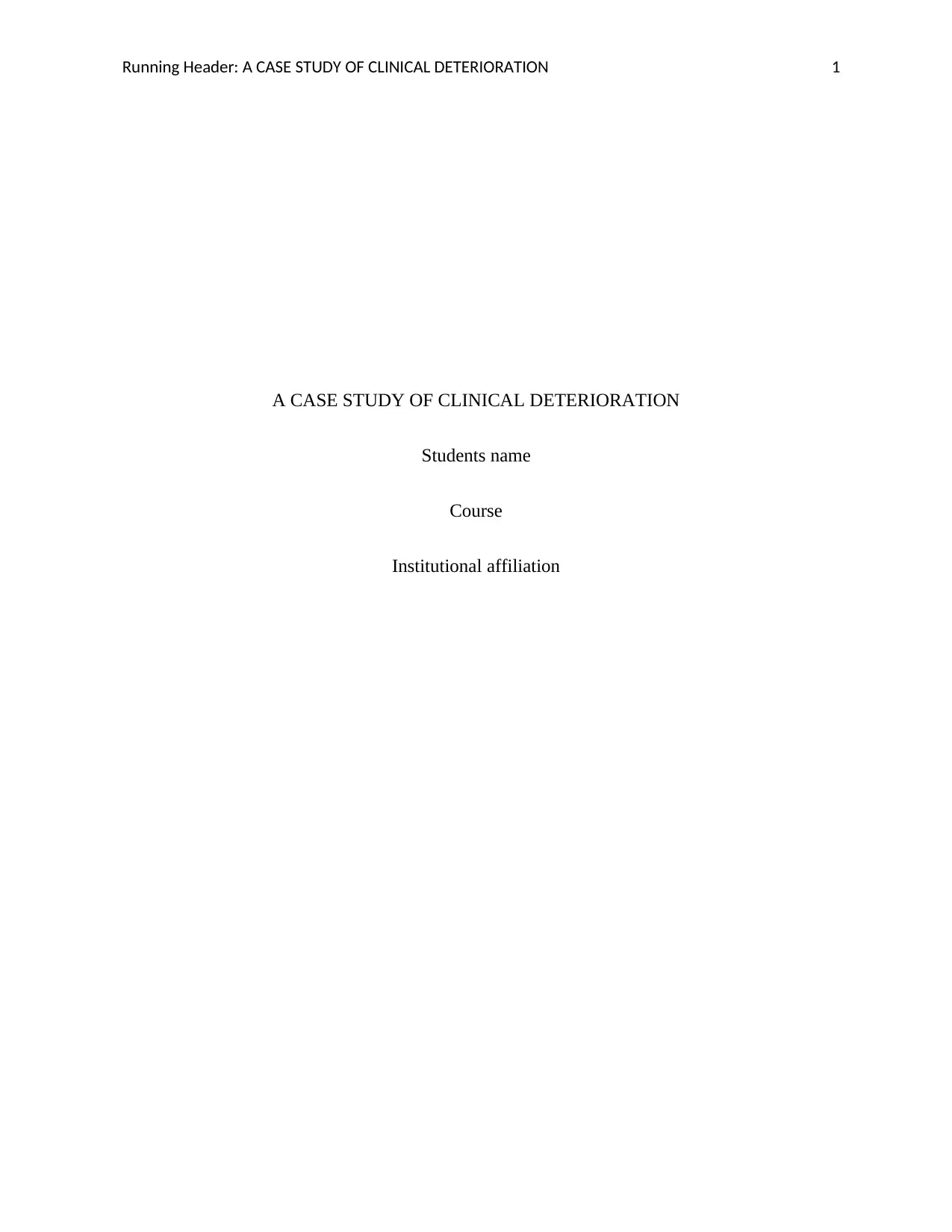
Running Header: A CASE STUDY OF CLINICAL DETERIORATION 1
A CASE STUDY OF CLINICAL DETERIORATION
Students name
Course
Institutional affiliation
A CASE STUDY OF CLINICAL DETERIORATION
Students name
Course
Institutional affiliation
Secure Best Marks with AI Grader
Need help grading? Try our AI Grader for instant feedback on your assignments.
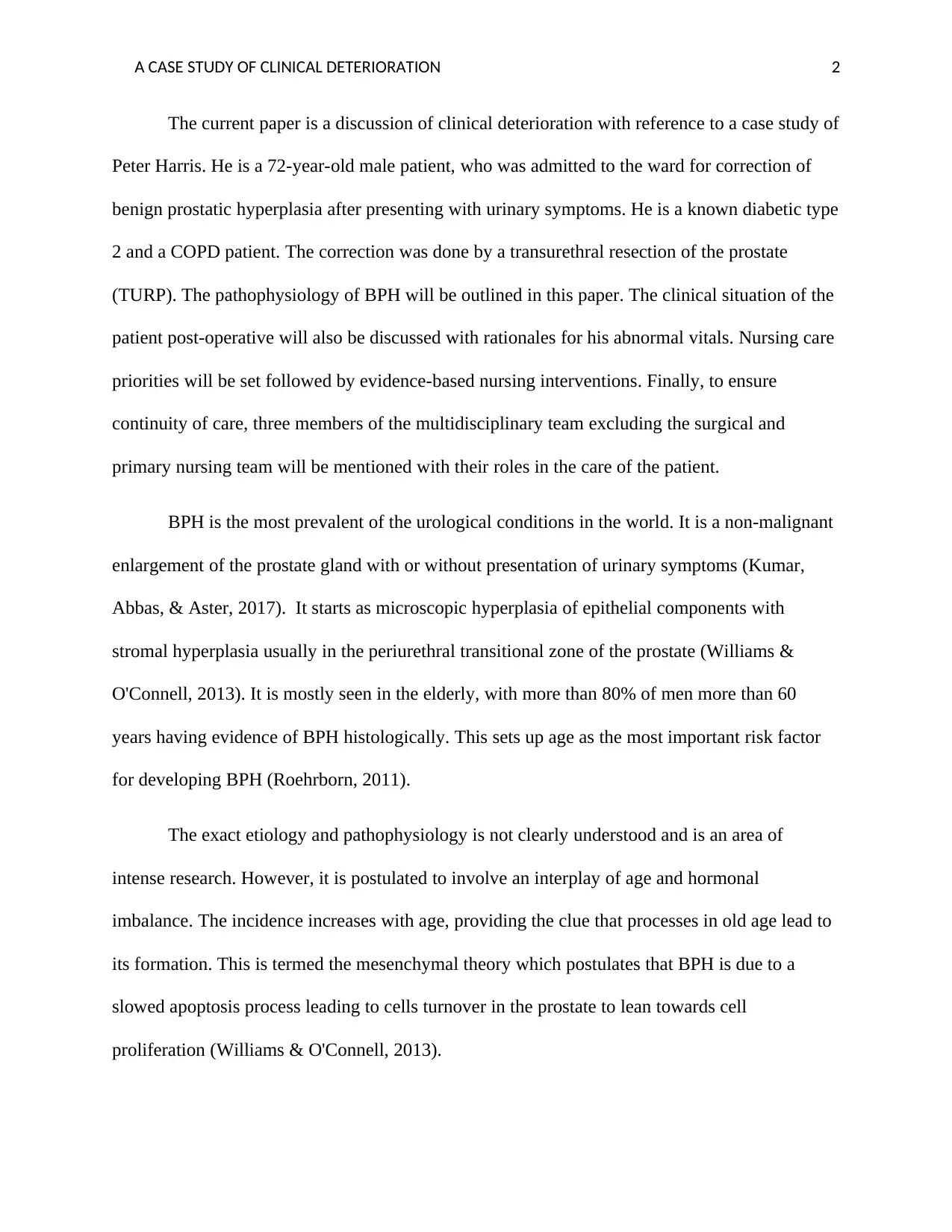
A CASE STUDY OF CLINICAL DETERIORATION 2
The current paper is a discussion of clinical deterioration with reference to a case study of
Peter Harris. He is a 72-year-old male patient, who was admitted to the ward for correction of
benign prostatic hyperplasia after presenting with urinary symptoms. He is a known diabetic type
2 and a COPD patient. The correction was done by a transurethral resection of the prostate
(TURP). The pathophysiology of BPH will be outlined in this paper. The clinical situation of the
patient post-operative will also be discussed with rationales for his abnormal vitals. Nursing care
priorities will be set followed by evidence-based nursing interventions. Finally, to ensure
continuity of care, three members of the multidisciplinary team excluding the surgical and
primary nursing team will be mentioned with their roles in the care of the patient.
BPH is the most prevalent of the urological conditions in the world. It is a non-malignant
enlargement of the prostate gland with or without presentation of urinary symptoms (Kumar,
Abbas, & Aster, 2017). It starts as microscopic hyperplasia of epithelial components with
stromal hyperplasia usually in the periurethral transitional zone of the prostate (Williams &
O'Connell, 2013). It is mostly seen in the elderly, with more than 80% of men more than 60
years having evidence of BPH histologically. This sets up age as the most important risk factor
for developing BPH (Roehrborn, 2011).
The exact etiology and pathophysiology is not clearly understood and is an area of
intense research. However, it is postulated to involve an interplay of age and hormonal
imbalance. The incidence increases with age, providing the clue that processes in old age lead to
its formation. This is termed the mesenchymal theory which postulates that BPH is due to a
slowed apoptosis process leading to cells turnover in the prostate to lean towards cell
proliferation (Williams & O'Connell, 2013).
The current paper is a discussion of clinical deterioration with reference to a case study of
Peter Harris. He is a 72-year-old male patient, who was admitted to the ward for correction of
benign prostatic hyperplasia after presenting with urinary symptoms. He is a known diabetic type
2 and a COPD patient. The correction was done by a transurethral resection of the prostate
(TURP). The pathophysiology of BPH will be outlined in this paper. The clinical situation of the
patient post-operative will also be discussed with rationales for his abnormal vitals. Nursing care
priorities will be set followed by evidence-based nursing interventions. Finally, to ensure
continuity of care, three members of the multidisciplinary team excluding the surgical and
primary nursing team will be mentioned with their roles in the care of the patient.
BPH is the most prevalent of the urological conditions in the world. It is a non-malignant
enlargement of the prostate gland with or without presentation of urinary symptoms (Kumar,
Abbas, & Aster, 2017). It starts as microscopic hyperplasia of epithelial components with
stromal hyperplasia usually in the periurethral transitional zone of the prostate (Williams &
O'Connell, 2013). It is mostly seen in the elderly, with more than 80% of men more than 60
years having evidence of BPH histologically. This sets up age as the most important risk factor
for developing BPH (Roehrborn, 2011).
The exact etiology and pathophysiology is not clearly understood and is an area of
intense research. However, it is postulated to involve an interplay of age and hormonal
imbalance. The incidence increases with age, providing the clue that processes in old age lead to
its formation. This is termed the mesenchymal theory which postulates that BPH is due to a
slowed apoptosis process leading to cells turnover in the prostate to lean towards cell
proliferation (Williams & O'Connell, 2013).

A CASE STUDY OF CLINICAL DETERIORATION 3
Hormones have been implicated in the pathogenesis of BPH including estrogen,
testosterone, prolactin and growth factors. The theory links BPH to an imbalance in these
hormones. Testosterone levels decrease with age but the others do not especially estrogen.
Unopposed effect of estrogen on epithelial and stromal cells is thought to lead to cellular
proliferation (Thor, 2015).
BPH is a histological diagnosis and does not necessarily mean it will cause
symptomatology. In fact, of the 80% of men over 60 who present with BPH, only 40 % will
develop the urinary symptoms (Roehrborn, 2011). The pathology will progress from prostatic
hyperplasia to prostatic enlargement that will finally lead to benign outflow obstruction. This
progression is, however, not definite as the size of the prostate poorly correlates with the
symptoms present.
Outflow obstruction presents the most important pathology leading to symptoms in BPH
(Sarma & Wei, 2012). However, other mechanisms exist to bring about symptoms. One is the
physiologic response of the bladder to outflow obstruction. The detrusor muscle hypertrophies
become less compliant and increase the blood supply. These new vessels are prone to rupture
causing hematuria in BPH. Another dynamic mechanism is the hypertrophy of prostatic smooth
muscles. These muscles have a rich adrenergic nerve supply hence hypertrophy increases the
adrenergic tone that is set on the prostatic urethra, worsening the obstruction (Sarma & Wei,
2012).
Lower urinary tract symptoms are characteristic in BPH and can either be obstructive or
irritative. Obstructive ones range from poor urine stream, dribbling, incomplete voiding,
straining, intermittency, and hesitancy. Irritative symptoms include nocturia, dysuria, urge
incontinence, and increased frequency (Lewis, Dirksen, & McLean, 2013). Other possible
Hormones have been implicated in the pathogenesis of BPH including estrogen,
testosterone, prolactin and growth factors. The theory links BPH to an imbalance in these
hormones. Testosterone levels decrease with age but the others do not especially estrogen.
Unopposed effect of estrogen on epithelial and stromal cells is thought to lead to cellular
proliferation (Thor, 2015).
BPH is a histological diagnosis and does not necessarily mean it will cause
symptomatology. In fact, of the 80% of men over 60 who present with BPH, only 40 % will
develop the urinary symptoms (Roehrborn, 2011). The pathology will progress from prostatic
hyperplasia to prostatic enlargement that will finally lead to benign outflow obstruction. This
progression is, however, not definite as the size of the prostate poorly correlates with the
symptoms present.
Outflow obstruction presents the most important pathology leading to symptoms in BPH
(Sarma & Wei, 2012). However, other mechanisms exist to bring about symptoms. One is the
physiologic response of the bladder to outflow obstruction. The detrusor muscle hypertrophies
become less compliant and increase the blood supply. These new vessels are prone to rupture
causing hematuria in BPH. Another dynamic mechanism is the hypertrophy of prostatic smooth
muscles. These muscles have a rich adrenergic nerve supply hence hypertrophy increases the
adrenergic tone that is set on the prostatic urethra, worsening the obstruction (Sarma & Wei,
2012).
Lower urinary tract symptoms are characteristic in BPH and can either be obstructive or
irritative. Obstructive ones range from poor urine stream, dribbling, incomplete voiding,
straining, intermittency, and hesitancy. Irritative symptoms include nocturia, dysuria, urge
incontinence, and increased frequency (Lewis, Dirksen, & McLean, 2013). Other possible
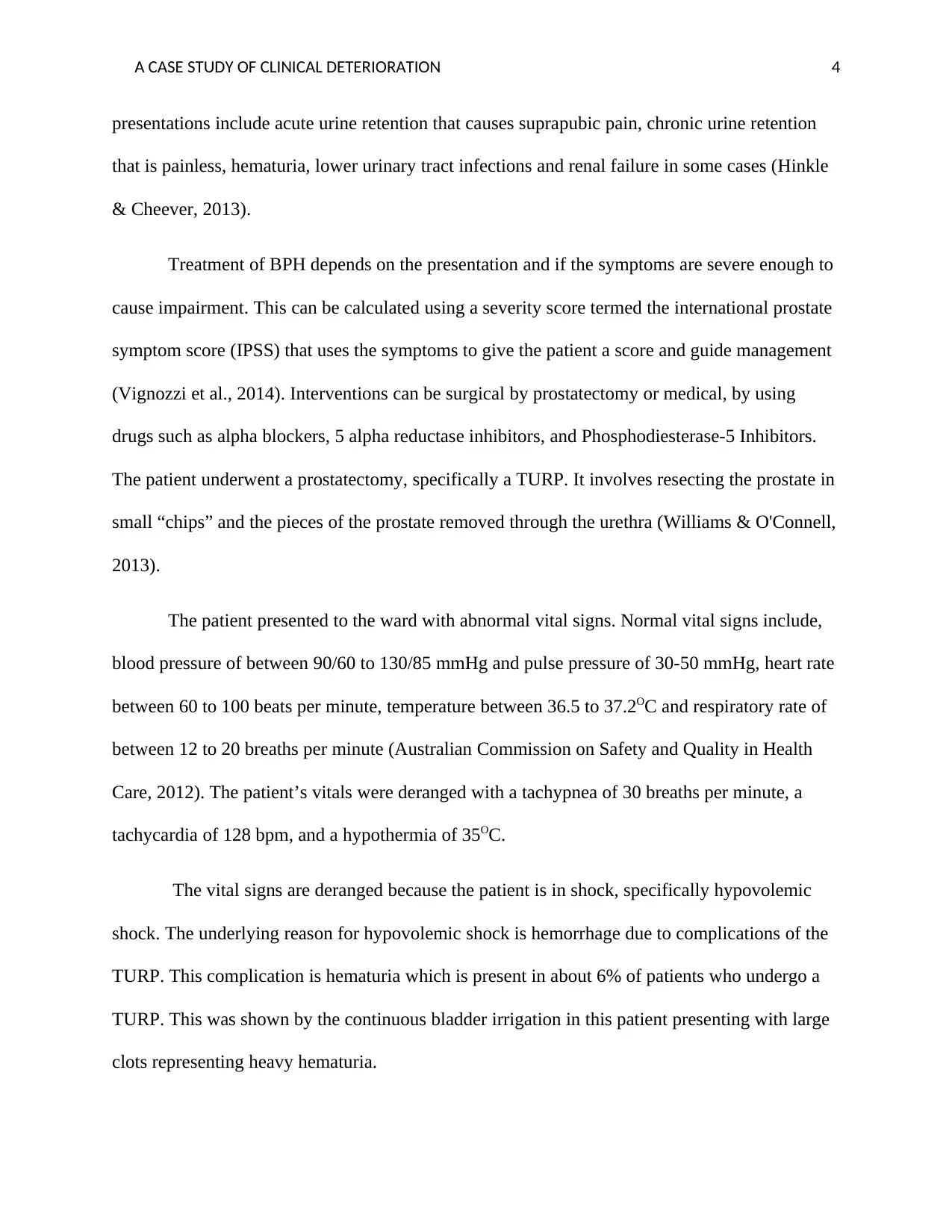
A CASE STUDY OF CLINICAL DETERIORATION 4
presentations include acute urine retention that causes suprapubic pain, chronic urine retention
that is painless, hematuria, lower urinary tract infections and renal failure in some cases (Hinkle
& Cheever, 2013).
Treatment of BPH depends on the presentation and if the symptoms are severe enough to
cause impairment. This can be calculated using a severity score termed the international prostate
symptom score (IPSS) that uses the symptoms to give the patient a score and guide management
(Vignozzi et al., 2014). Interventions can be surgical by prostatectomy or medical, by using
drugs such as alpha blockers, 5 alpha reductase inhibitors, and Phosphodiesterase-5 Inhibitors.
The patient underwent a prostatectomy, specifically a TURP. It involves resecting the prostate in
small “chips” and the pieces of the prostate removed through the urethra (Williams & O'Connell,
2013).
The patient presented to the ward with abnormal vital signs. Normal vital signs include,
blood pressure of between 90/60 to 130/85 mmHg and pulse pressure of 30-50 mmHg, heart rate
between 60 to 100 beats per minute, temperature between 36.5 to 37.2OC and respiratory rate of
between 12 to 20 breaths per minute (Australian Commission on Safety and Quality in Health
Care, 2012). The patient’s vitals were deranged with a tachypnea of 30 breaths per minute, a
tachycardia of 128 bpm, and a hypothermia of 35OC.
The vital signs are deranged because the patient is in shock, specifically hypovolemic
shock. The underlying reason for hypovolemic shock is hemorrhage due to complications of the
TURP. This complication is hematuria which is present in about 6% of patients who undergo a
TURP. This was shown by the continuous bladder irrigation in this patient presenting with large
clots representing heavy hematuria.
presentations include acute urine retention that causes suprapubic pain, chronic urine retention
that is painless, hematuria, lower urinary tract infections and renal failure in some cases (Hinkle
& Cheever, 2013).
Treatment of BPH depends on the presentation and if the symptoms are severe enough to
cause impairment. This can be calculated using a severity score termed the international prostate
symptom score (IPSS) that uses the symptoms to give the patient a score and guide management
(Vignozzi et al., 2014). Interventions can be surgical by prostatectomy or medical, by using
drugs such as alpha blockers, 5 alpha reductase inhibitors, and Phosphodiesterase-5 Inhibitors.
The patient underwent a prostatectomy, specifically a TURP. It involves resecting the prostate in
small “chips” and the pieces of the prostate removed through the urethra (Williams & O'Connell,
2013).
The patient presented to the ward with abnormal vital signs. Normal vital signs include,
blood pressure of between 90/60 to 130/85 mmHg and pulse pressure of 30-50 mmHg, heart rate
between 60 to 100 beats per minute, temperature between 36.5 to 37.2OC and respiratory rate of
between 12 to 20 breaths per minute (Australian Commission on Safety and Quality in Health
Care, 2012). The patient’s vitals were deranged with a tachypnea of 30 breaths per minute, a
tachycardia of 128 bpm, and a hypothermia of 35OC.
The vital signs are deranged because the patient is in shock, specifically hypovolemic
shock. The underlying reason for hypovolemic shock is hemorrhage due to complications of the
TURP. This complication is hematuria which is present in about 6% of patients who undergo a
TURP. This was shown by the continuous bladder irrigation in this patient presenting with large
clots representing heavy hematuria.
Secure Best Marks with AI Grader
Need help grading? Try our AI Grader for instant feedback on your assignments.
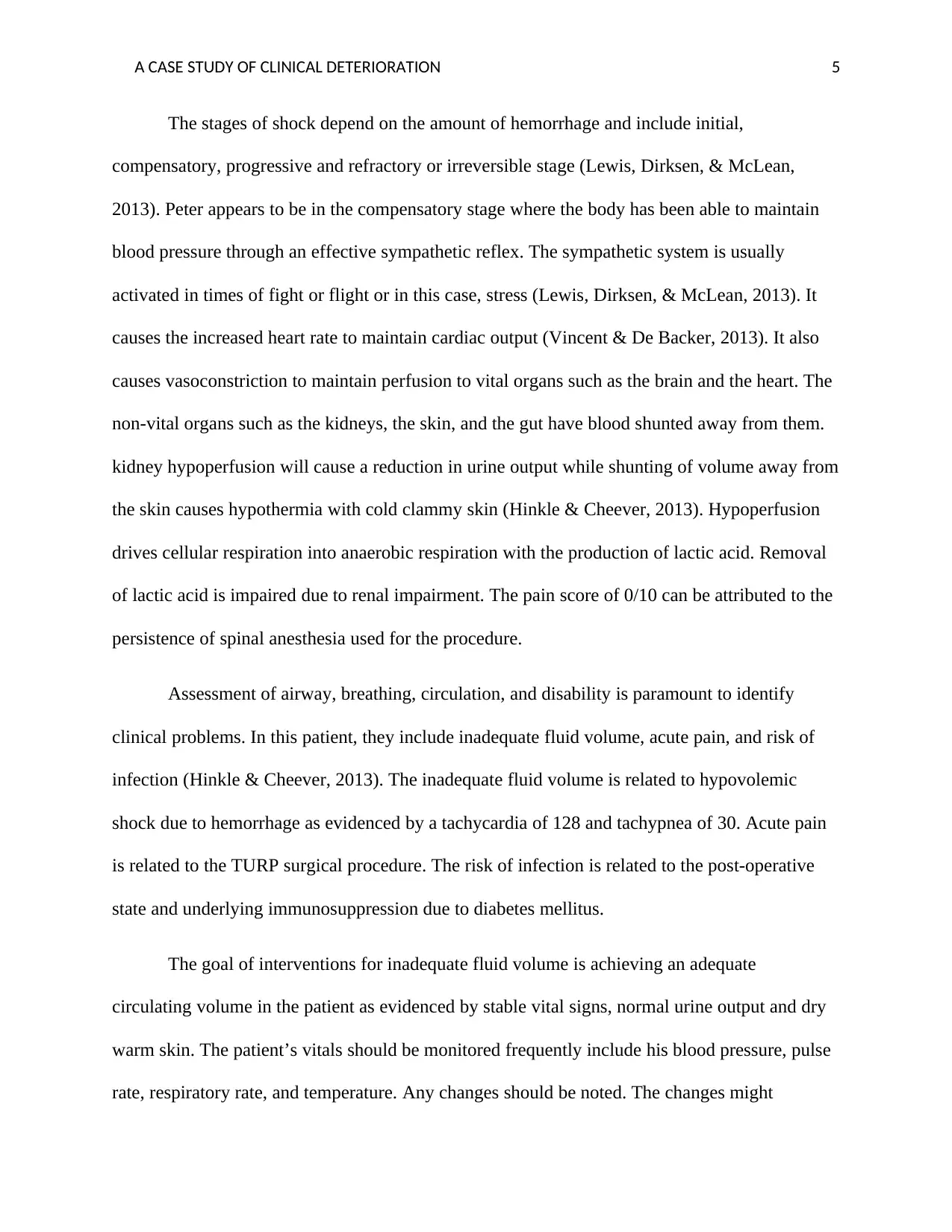
A CASE STUDY OF CLINICAL DETERIORATION 5
The stages of shock depend on the amount of hemorrhage and include initial,
compensatory, progressive and refractory or irreversible stage (Lewis, Dirksen, & McLean,
2013). Peter appears to be in the compensatory stage where the body has been able to maintain
blood pressure through an effective sympathetic reflex. The sympathetic system is usually
activated in times of fight or flight or in this case, stress (Lewis, Dirksen, & McLean, 2013). It
causes the increased heart rate to maintain cardiac output (Vincent & De Backer, 2013). It also
causes vasoconstriction to maintain perfusion to vital organs such as the brain and the heart. The
non-vital organs such as the kidneys, the skin, and the gut have blood shunted away from them.
kidney hypoperfusion will cause a reduction in urine output while shunting of volume away from
the skin causes hypothermia with cold clammy skin (Hinkle & Cheever, 2013). Hypoperfusion
drives cellular respiration into anaerobic respiration with the production of lactic acid. Removal
of lactic acid is impaired due to renal impairment. The pain score of 0/10 can be attributed to the
persistence of spinal anesthesia used for the procedure.
Assessment of airway, breathing, circulation, and disability is paramount to identify
clinical problems. In this patient, they include inadequate fluid volume, acute pain, and risk of
infection (Hinkle & Cheever, 2013). The inadequate fluid volume is related to hypovolemic
shock due to hemorrhage as evidenced by a tachycardia of 128 and tachypnea of 30. Acute pain
is related to the TURP surgical procedure. The risk of infection is related to the post-operative
state and underlying immunosuppression due to diabetes mellitus.
The goal of interventions for inadequate fluid volume is achieving an adequate
circulating volume in the patient as evidenced by stable vital signs, normal urine output and dry
warm skin. The patient’s vitals should be monitored frequently include his blood pressure, pulse
rate, respiratory rate, and temperature. Any changes should be noted. The changes might
The stages of shock depend on the amount of hemorrhage and include initial,
compensatory, progressive and refractory or irreversible stage (Lewis, Dirksen, & McLean,
2013). Peter appears to be in the compensatory stage where the body has been able to maintain
blood pressure through an effective sympathetic reflex. The sympathetic system is usually
activated in times of fight or flight or in this case, stress (Lewis, Dirksen, & McLean, 2013). It
causes the increased heart rate to maintain cardiac output (Vincent & De Backer, 2013). It also
causes vasoconstriction to maintain perfusion to vital organs such as the brain and the heart. The
non-vital organs such as the kidneys, the skin, and the gut have blood shunted away from them.
kidney hypoperfusion will cause a reduction in urine output while shunting of volume away from
the skin causes hypothermia with cold clammy skin (Hinkle & Cheever, 2013). Hypoperfusion
drives cellular respiration into anaerobic respiration with the production of lactic acid. Removal
of lactic acid is impaired due to renal impairment. The pain score of 0/10 can be attributed to the
persistence of spinal anesthesia used for the procedure.
Assessment of airway, breathing, circulation, and disability is paramount to identify
clinical problems. In this patient, they include inadequate fluid volume, acute pain, and risk of
infection (Hinkle & Cheever, 2013). The inadequate fluid volume is related to hypovolemic
shock due to hemorrhage as evidenced by a tachycardia of 128 and tachypnea of 30. Acute pain
is related to the TURP surgical procedure. The risk of infection is related to the post-operative
state and underlying immunosuppression due to diabetes mellitus.
The goal of interventions for inadequate fluid volume is achieving an adequate
circulating volume in the patient as evidenced by stable vital signs, normal urine output and dry
warm skin. The patient’s vitals should be monitored frequently include his blood pressure, pulse
rate, respiratory rate, and temperature. Any changes should be noted. The changes might
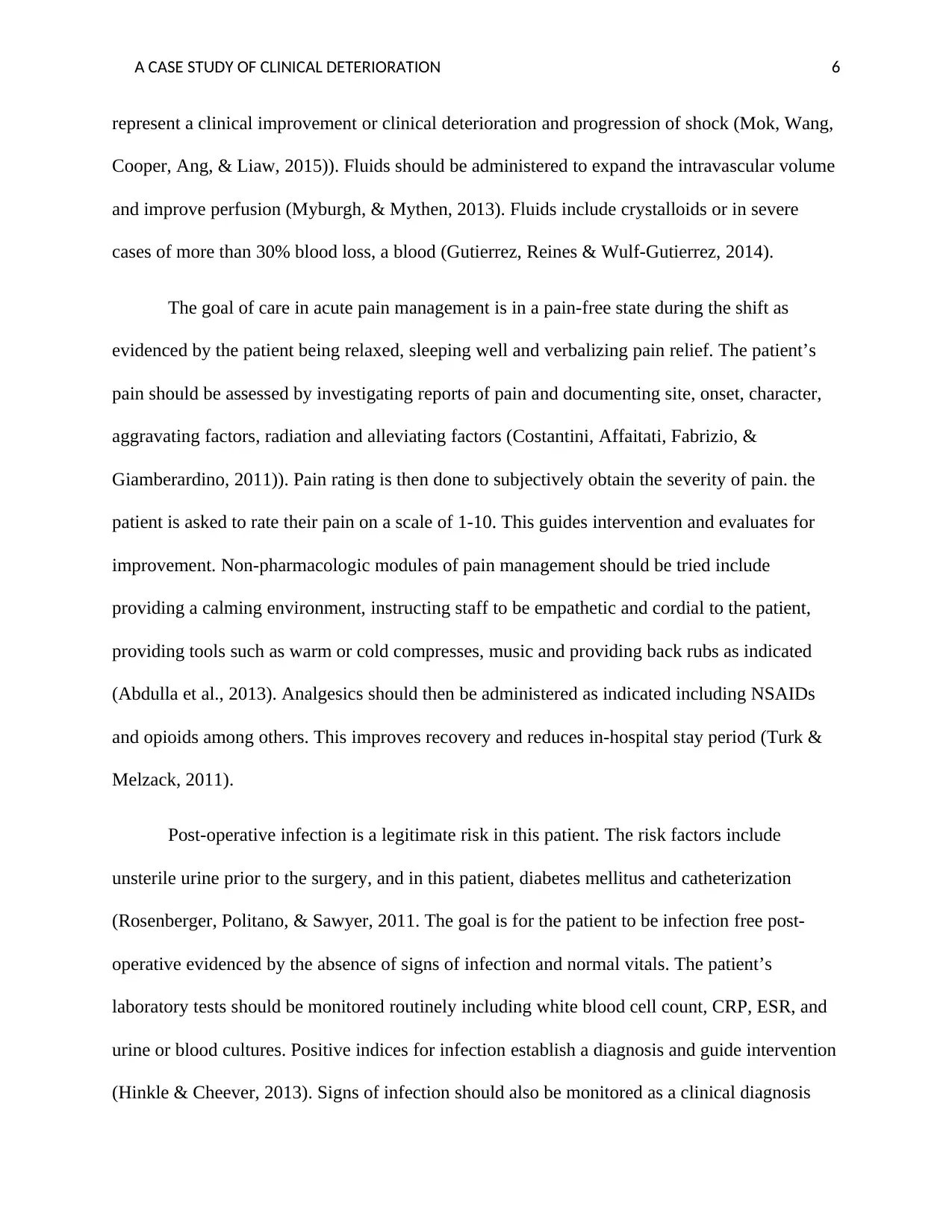
A CASE STUDY OF CLINICAL DETERIORATION 6
represent a clinical improvement or clinical deterioration and progression of shock (Mok, Wang,
Cooper, Ang, & Liaw, 2015)). Fluids should be administered to expand the intravascular volume
and improve perfusion (Myburgh, & Mythen, 2013). Fluids include crystalloids or in severe
cases of more than 30% blood loss, a blood (Gutierrez, Reines & Wulf-Gutierrez, 2014).
The goal of care in acute pain management is in a pain-free state during the shift as
evidenced by the patient being relaxed, sleeping well and verbalizing pain relief. The patient’s
pain should be assessed by investigating reports of pain and documenting site, onset, character,
aggravating factors, radiation and alleviating factors (Costantini, Affaitati, Fabrizio, &
Giamberardino, 2011)). Pain rating is then done to subjectively obtain the severity of pain. the
patient is asked to rate their pain on a scale of 1-10. This guides intervention and evaluates for
improvement. Non-pharmacologic modules of pain management should be tried include
providing a calming environment, instructing staff to be empathetic and cordial to the patient,
providing tools such as warm or cold compresses, music and providing back rubs as indicated
(Abdulla et al., 2013). Analgesics should then be administered as indicated including NSAIDs
and opioids among others. This improves recovery and reduces in-hospital stay period (Turk &
Melzack, 2011).
Post-operative infection is a legitimate risk in this patient. The risk factors include
unsterile urine prior to the surgery, and in this patient, diabetes mellitus and catheterization
(Rosenberger, Politano, & Sawyer, 2011. The goal is for the patient to be infection free post-
operative evidenced by the absence of signs of infection and normal vitals. The patient’s
laboratory tests should be monitored routinely including white blood cell count, CRP, ESR, and
urine or blood cultures. Positive indices for infection establish a diagnosis and guide intervention
(Hinkle & Cheever, 2013). Signs of infection should also be monitored as a clinical diagnosis
represent a clinical improvement or clinical deterioration and progression of shock (Mok, Wang,
Cooper, Ang, & Liaw, 2015)). Fluids should be administered to expand the intravascular volume
and improve perfusion (Myburgh, & Mythen, 2013). Fluids include crystalloids or in severe
cases of more than 30% blood loss, a blood (Gutierrez, Reines & Wulf-Gutierrez, 2014).
The goal of care in acute pain management is in a pain-free state during the shift as
evidenced by the patient being relaxed, sleeping well and verbalizing pain relief. The patient’s
pain should be assessed by investigating reports of pain and documenting site, onset, character,
aggravating factors, radiation and alleviating factors (Costantini, Affaitati, Fabrizio, &
Giamberardino, 2011)). Pain rating is then done to subjectively obtain the severity of pain. the
patient is asked to rate their pain on a scale of 1-10. This guides intervention and evaluates for
improvement. Non-pharmacologic modules of pain management should be tried include
providing a calming environment, instructing staff to be empathetic and cordial to the patient,
providing tools such as warm or cold compresses, music and providing back rubs as indicated
(Abdulla et al., 2013). Analgesics should then be administered as indicated including NSAIDs
and opioids among others. This improves recovery and reduces in-hospital stay period (Turk &
Melzack, 2011).
Post-operative infection is a legitimate risk in this patient. The risk factors include
unsterile urine prior to the surgery, and in this patient, diabetes mellitus and catheterization
(Rosenberger, Politano, & Sawyer, 2011. The goal is for the patient to be infection free post-
operative evidenced by the absence of signs of infection and normal vitals. The patient’s
laboratory tests should be monitored routinely including white blood cell count, CRP, ESR, and
urine or blood cultures. Positive indices for infection establish a diagnosis and guide intervention
(Hinkle & Cheever, 2013). Signs of infection should also be monitored as a clinical diagnosis
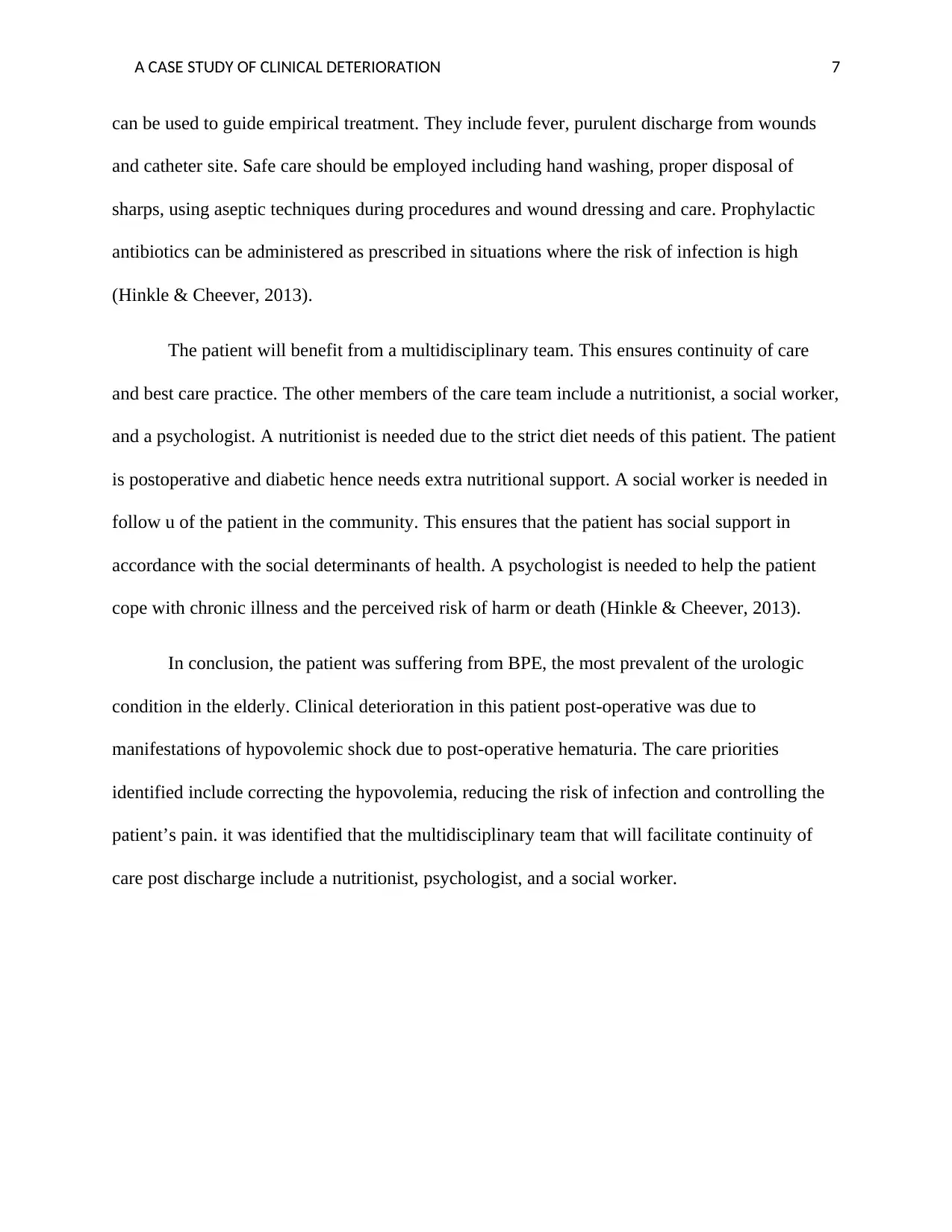
A CASE STUDY OF CLINICAL DETERIORATION 7
can be used to guide empirical treatment. They include fever, purulent discharge from wounds
and catheter site. Safe care should be employed including hand washing, proper disposal of
sharps, using aseptic techniques during procedures and wound dressing and care. Prophylactic
antibiotics can be administered as prescribed in situations where the risk of infection is high
(Hinkle & Cheever, 2013).
The patient will benefit from a multidisciplinary team. This ensures continuity of care
and best care practice. The other members of the care team include a nutritionist, a social worker,
and a psychologist. A nutritionist is needed due to the strict diet needs of this patient. The patient
is postoperative and diabetic hence needs extra nutritional support. A social worker is needed in
follow u of the patient in the community. This ensures that the patient has social support in
accordance with the social determinants of health. A psychologist is needed to help the patient
cope with chronic illness and the perceived risk of harm or death (Hinkle & Cheever, 2013).
In conclusion, the patient was suffering from BPE, the most prevalent of the urologic
condition in the elderly. Clinical deterioration in this patient post-operative was due to
manifestations of hypovolemic shock due to post-operative hematuria. The care priorities
identified include correcting the hypovolemia, reducing the risk of infection and controlling the
patient’s pain. it was identified that the multidisciplinary team that will facilitate continuity of
care post discharge include a nutritionist, psychologist, and a social worker.
can be used to guide empirical treatment. They include fever, purulent discharge from wounds
and catheter site. Safe care should be employed including hand washing, proper disposal of
sharps, using aseptic techniques during procedures and wound dressing and care. Prophylactic
antibiotics can be administered as prescribed in situations where the risk of infection is high
(Hinkle & Cheever, 2013).
The patient will benefit from a multidisciplinary team. This ensures continuity of care
and best care practice. The other members of the care team include a nutritionist, a social worker,
and a psychologist. A nutritionist is needed due to the strict diet needs of this patient. The patient
is postoperative and diabetic hence needs extra nutritional support. A social worker is needed in
follow u of the patient in the community. This ensures that the patient has social support in
accordance with the social determinants of health. A psychologist is needed to help the patient
cope with chronic illness and the perceived risk of harm or death (Hinkle & Cheever, 2013).
In conclusion, the patient was suffering from BPE, the most prevalent of the urologic
condition in the elderly. Clinical deterioration in this patient post-operative was due to
manifestations of hypovolemic shock due to post-operative hematuria. The care priorities
identified include correcting the hypovolemia, reducing the risk of infection and controlling the
patient’s pain. it was identified that the multidisciplinary team that will facilitate continuity of
care post discharge include a nutritionist, psychologist, and a social worker.
Paraphrase This Document
Need a fresh take? Get an instant paraphrase of this document with our AI Paraphraser
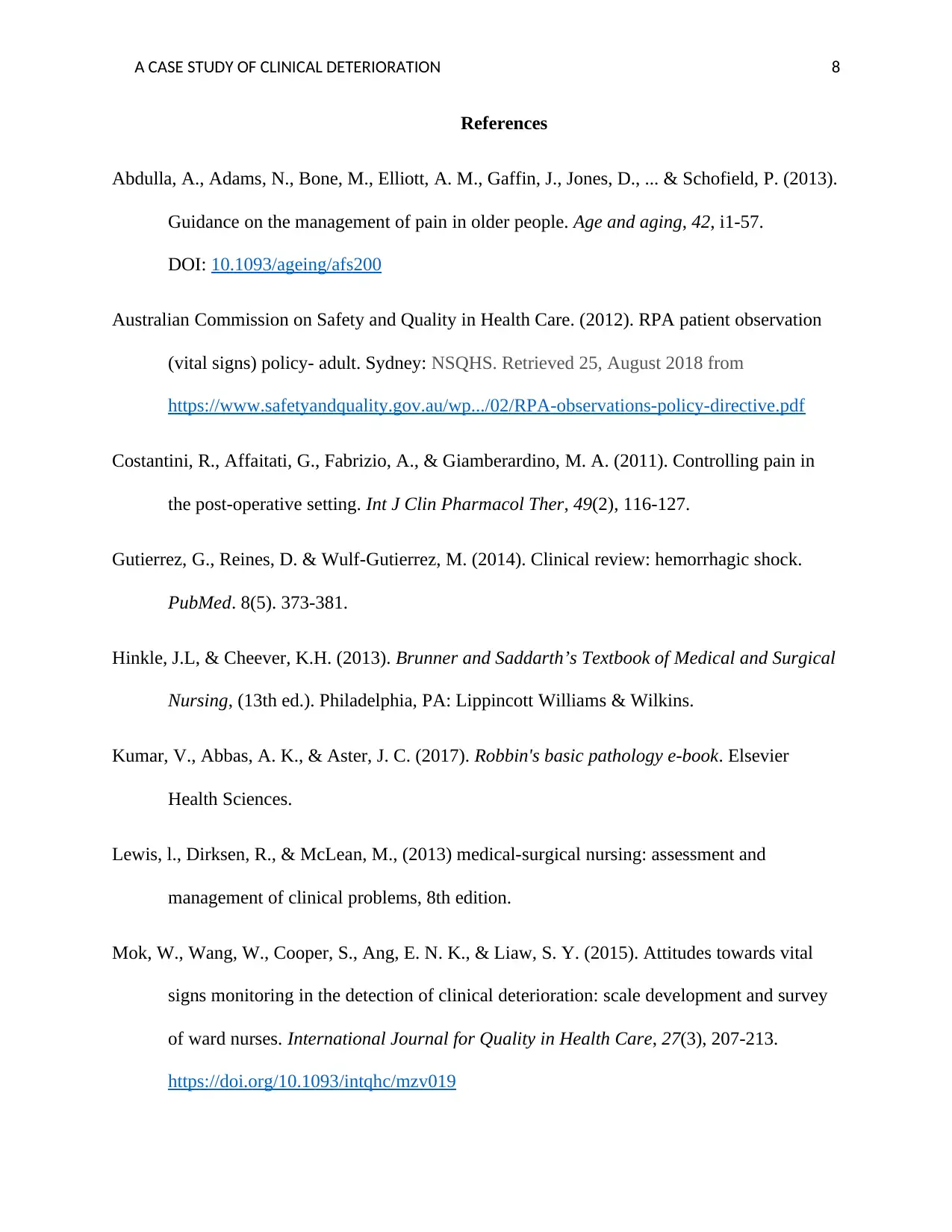
A CASE STUDY OF CLINICAL DETERIORATION 8
References
Abdulla, A., Adams, N., Bone, M., Elliott, A. M., Gaffin, J., Jones, D., ... & Schofield, P. (2013).
Guidance on the management of pain in older people. Age and aging, 42, i1-57.
DOI: 10.1093/ageing/afs200
Australian Commission on Safety and Quality in Health Care. (2012). RPA patient observation
(vital signs) policy- adult. Sydney: NSQHS. Retrieved 25, August 2018 from
https://www.safetyandquality.gov.au/wp.../02/RPA-observations-policy-directive.pdf
Costantini, R., Affaitati, G., Fabrizio, A., & Giamberardino, M. A. (2011). Controlling pain in
the post-operative setting. Int J Clin Pharmacol Ther, 49(2), 116-127.
Gutierrez, G., Reines, D. & Wulf-Gutierrez, M. (2014). Clinical review: hemorrhagic shock.
PubMed. 8(5). 373-381.
Hinkle, J.L, & Cheever, K.H. (2013). Brunner and Saddarth’s Textbook of Medical and Surgical
Nursing, (13th ed.). Philadelphia, PA: Lippincott Williams & Wilkins.
Kumar, V., Abbas, A. K., & Aster, J. C. (2017). Robbin's basic pathology e-book. Elsevier
Health Sciences.
Lewis, l., Dirksen, R., & McLean, M., (2013) medical-surgical nursing: assessment and
management of clinical problems, 8th edition.
Mok, W., Wang, W., Cooper, S., Ang, E. N. K., & Liaw, S. Y. (2015). Attitudes towards vital
signs monitoring in the detection of clinical deterioration: scale development and survey
of ward nurses. International Journal for Quality in Health Care, 27(3), 207-213.
https://doi.org/10.1093/intqhc/mzv019
References
Abdulla, A., Adams, N., Bone, M., Elliott, A. M., Gaffin, J., Jones, D., ... & Schofield, P. (2013).
Guidance on the management of pain in older people. Age and aging, 42, i1-57.
DOI: 10.1093/ageing/afs200
Australian Commission on Safety and Quality in Health Care. (2012). RPA patient observation
(vital signs) policy- adult. Sydney: NSQHS. Retrieved 25, August 2018 from
https://www.safetyandquality.gov.au/wp.../02/RPA-observations-policy-directive.pdf
Costantini, R., Affaitati, G., Fabrizio, A., & Giamberardino, M. A. (2011). Controlling pain in
the post-operative setting. Int J Clin Pharmacol Ther, 49(2), 116-127.
Gutierrez, G., Reines, D. & Wulf-Gutierrez, M. (2014). Clinical review: hemorrhagic shock.
PubMed. 8(5). 373-381.
Hinkle, J.L, & Cheever, K.H. (2013). Brunner and Saddarth’s Textbook of Medical and Surgical
Nursing, (13th ed.). Philadelphia, PA: Lippincott Williams & Wilkins.
Kumar, V., Abbas, A. K., & Aster, J. C. (2017). Robbin's basic pathology e-book. Elsevier
Health Sciences.
Lewis, l., Dirksen, R., & McLean, M., (2013) medical-surgical nursing: assessment and
management of clinical problems, 8th edition.
Mok, W., Wang, W., Cooper, S., Ang, E. N. K., & Liaw, S. Y. (2015). Attitudes towards vital
signs monitoring in the detection of clinical deterioration: scale development and survey
of ward nurses. International Journal for Quality in Health Care, 27(3), 207-213.
https://doi.org/10.1093/intqhc/mzv019
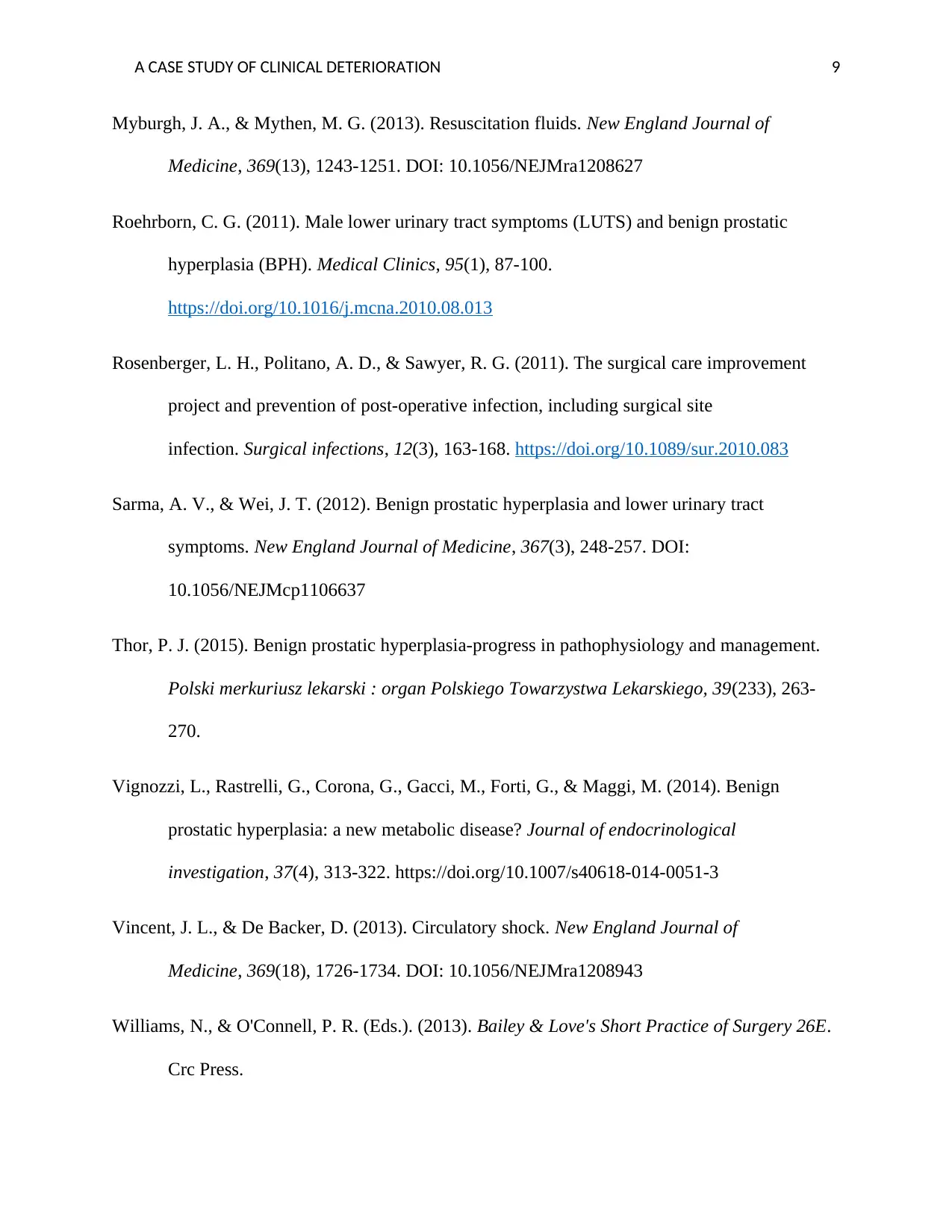
A CASE STUDY OF CLINICAL DETERIORATION 9
Myburgh, J. A., & Mythen, M. G. (2013). Resuscitation fluids. New England Journal of
Medicine, 369(13), 1243-1251. DOI: 10.1056/NEJMra1208627
Roehrborn, C. G. (2011). Male lower urinary tract symptoms (LUTS) and benign prostatic
hyperplasia (BPH). Medical Clinics, 95(1), 87-100.
https://doi.org/10.1016/j.mcna.2010.08.013
Rosenberger, L. H., Politano, A. D., & Sawyer, R. G. (2011). The surgical care improvement
project and prevention of post-operative infection, including surgical site
infection. Surgical infections, 12(3), 163-168. https://doi.org/10.1089/sur.2010.083
Sarma, A. V., & Wei, J. T. (2012). Benign prostatic hyperplasia and lower urinary tract
symptoms. New England Journal of Medicine, 367(3), 248-257. DOI:
10.1056/NEJMcp1106637
Thor, P. J. (2015). Benign prostatic hyperplasia-progress in pathophysiology and management.
Polski merkuriusz lekarski : organ Polskiego Towarzystwa Lekarskiego, 39(233), 263-
270.
Vignozzi, L., Rastrelli, G., Corona, G., Gacci, M., Forti, G., & Maggi, M. (2014). Benign
prostatic hyperplasia: a new metabolic disease? Journal of endocrinological
investigation, 37(4), 313-322. https://doi.org/10.1007/s40618-014-0051-3
Vincent, J. L., & De Backer, D. (2013). Circulatory shock. New England Journal of
Medicine, 369(18), 1726-1734. DOI: 10.1056/NEJMra1208943
Williams, N., & O'Connell, P. R. (Eds.). (2013). Bailey & Love's Short Practice of Surgery 26E.
Crc Press.
Myburgh, J. A., & Mythen, M. G. (2013). Resuscitation fluids. New England Journal of
Medicine, 369(13), 1243-1251. DOI: 10.1056/NEJMra1208627
Roehrborn, C. G. (2011). Male lower urinary tract symptoms (LUTS) and benign prostatic
hyperplasia (BPH). Medical Clinics, 95(1), 87-100.
https://doi.org/10.1016/j.mcna.2010.08.013
Rosenberger, L. H., Politano, A. D., & Sawyer, R. G. (2011). The surgical care improvement
project and prevention of post-operative infection, including surgical site
infection. Surgical infections, 12(3), 163-168. https://doi.org/10.1089/sur.2010.083
Sarma, A. V., & Wei, J. T. (2012). Benign prostatic hyperplasia and lower urinary tract
symptoms. New England Journal of Medicine, 367(3), 248-257. DOI:
10.1056/NEJMcp1106637
Thor, P. J. (2015). Benign prostatic hyperplasia-progress in pathophysiology and management.
Polski merkuriusz lekarski : organ Polskiego Towarzystwa Lekarskiego, 39(233), 263-
270.
Vignozzi, L., Rastrelli, G., Corona, G., Gacci, M., Forti, G., & Maggi, M. (2014). Benign
prostatic hyperplasia: a new metabolic disease? Journal of endocrinological
investigation, 37(4), 313-322. https://doi.org/10.1007/s40618-014-0051-3
Vincent, J. L., & De Backer, D. (2013). Circulatory shock. New England Journal of
Medicine, 369(18), 1726-1734. DOI: 10.1056/NEJMra1208943
Williams, N., & O'Connell, P. R. (Eds.). (2013). Bailey & Love's Short Practice of Surgery 26E.
Crc Press.
1 out of 9
Related Documents
Your All-in-One AI-Powered Toolkit for Academic Success.
+13062052269
info@desklib.com
Available 24*7 on WhatsApp / Email
![[object Object]](/_next/static/media/star-bottom.7253800d.svg)
Unlock your academic potential
© 2024 | Zucol Services PVT LTD | All rights reserved.





